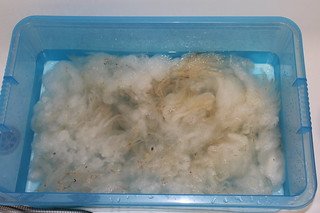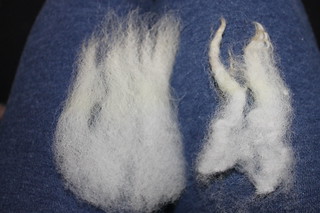Featuring;
Free farm wool fleece- a yarn ‘spun from the lock’ (bottom)
Alpaca fleece – a laceweight yarn spun from a hand carded worsted preparation from alpaca fleece (top)
A combination of both wool and alpaca fleeces to make a hand carded worsted prep to spin a Navajo-plied/3-ply sock yarn (middle)
There’s been so much interesting information on the Wovember blog, I wanted to join in as I just love all things sheepy and woolly! So here are some of my efforts to promote/show off wool – where it comes from, and a bit about how it is ‘worked with’ and prepared, and what it has to go through to become yarn for knitting (I spun and finished these yarns for knitting, not weaving as I haven’t learned any real weaving as of yet! I haven’t knitted with any of these yarns yet either – looking for the ‘right’ patterns!)
After dyeing lots of commercial top, I wanted to work with some natural coloured wool in fleece form, and show off how nice wool can be in its un-dyed state. I’ll talk a little bit about the process from fleece to yarn (the processes that I use anyway – everyone’s different!) that I used to make the above skeins of yarn, and the traditional hand-spinning and plying techniques and preparation and blending on hand carders that were used. Here goes..
Hand-washing/scouring fleece.
(I’ll be doing a whole separate post on just washing the fleece in a future post – stay tuned!)
This is where sheep’s wool comes from! Haha. Sheep love to photobomb..
I had a bag of raw alpaca fleece I got from Fibre East festival and some raw wool I was kindly given on a camping trip a while ago (so I’m not sure what sheep breed this is, anyone want to guess?), which before I even began to think about spinning yarn(s), I had to skirt it, (preliminary) pick it (pick all the vegetable matter ‘vm‘ out of it), wash and dry it, and pick it again.
Some raw farm wool full of lovely lanolin.
The white farm wool being washed (This is on it’s rinse stage!)
Some dried crimpy locks just before carding the final bits of dirt and vm out.
Alpaca fleece air drying. Lovely natural ‘black’.
A softer-than-soft black alpaca lock, air drying.
Preparing the washed and dried fleece for spinning.
Once the fleeces were dry, I would prepare the fiber for spinning by picking the locks and carding on hand cards. I only have one wheel so I had to spin and ply each skein individually, one after the other. The first skein I made was the 100% natural black alpaca, with which I grabbed a handful of locks and lay them on the carder, and carded til the fibers were aligned and spinnable, then rolled the ‘web’ of fibers from right to left to make a sort of worsted preparation (where all the fibers are facing the same way, as opposed to a woollen preparation where the fibers criss-cross each other in rolag form, which you make by rolling it from bottom to top). The thing that took the most time was getting the little grass seeds out of some of the locks. I had to pick them out manually because my carders are only 72 tpi (teeth per inch) and I need a finer gauge of carding cloth for alpaca I think, but I do with what I’ve got until I can acquire better stuff! For the grey skein I aimed for a 70/30 alpaca/wool blend (which I gauged by eye as opposed to weight) and carded the same way as the 100% black alpaca.
Carded 100% natural black alpaca locks ready for spinning. Plus a little sample of the finished yarn. I always make a sample!
Black alpaca and white wool on the carder ready to be blended.
Alpaca and wool ‘web’ being rolled into a sort of worsted preparation.
The alpaca and wool blend is now ready for spinning!
For the bouncy white wool skein, I took locks individually from the fleece and flicked both ends with a carder and just made a pile of them and spun them without any hard-core carding.
Left: Flicked lock. Right: Lock before flicking. Any dirty tips are usually clean by the time you’ve finished flicking the ends.
Techniques used for spinning and plying the skeins of yarn from their preparations.
Once all the prep work has been done you can finally spin the fiber! With each of the three skeins I’d spin a semi-worsted single (I used a medium backward draw or a ‘double draw’ and gently smoothed back the fibers before drafting again) then chose to either 2-ply or Navajo ply (which gave me a 3-ply yarn – maybe a post on navajo plying later). For the 100% black alpaca I spun a very fine single (I had to modify my wheel to spin for lace, involving a rubber band and a piece of string..) with a medium/high twist over two bobbins;
Singles on their bobbins waiting to be plied.
Single with a halo.
2-ply laceweight yarn. Plying didn’t really bulk out this yarn and it’s very light and so soft.
Then I plied them together – which actually took me 3 hours. I do not have a very speedy wheel 🙂
Cascading alpaca softness.
For the bouncy white wool skein I took the longest and crimpiest locks and ‘spun from the lock’ over two bobbins. I aimed to achieve a quite chubby single, purely because after spinning that alpaca so fine, I needed a break, but I think it suited this wool quite nicely. Then I plied them together for a nice squishy 2-ply. It took a bit of time to get the hang of spinning from the lock, it involves quite a lot of stop and start but I found it quite enjoyable working straight from the crimpy locks. To spin from the lock you need them long enough to be able to grip onto it – not tightly but you need enough length of fiber in your hand, and if they’re too short you won’t be able to grip on to anything! With all the shorter bits and waste fluff I carded it all up and used for stuffing for some mini poufs/cushions which I’ll show in another post.
A bouncy bobbin full of 2-ply.
A very energised skein, straight off the bobbin.
And finally, for the grey alpaca and wool blend skein, I spun one bobbin full of fine singles with a slightly higher amount of twist, to be able to endure the Navajo plying, to make a yarn for some chain ply socks.
Spun single on the bobbin waiting to be plied.
A fuzzy 3-ply yarn. The wool adds strength to the alpaca in the yarn, and so does the Navajo plying.
Alpaca/wool blend straight off the bobbin.
Finishing techniques.
Before I use hand-spun for knitting, I wash and ‘finish’ the yarn using a technique called ‘fulling’. There is information out there on the different techniques for finishing yarn, but I like this one for wool, especially 100% wool singles yarns as it helps keep the yarn from drifting apart whilst knitting with it, and I have managed to ‘de-energise’ some yarns that otherwise would have been pretty squirly to work with to say the least! It seems to allow the yarn to bloom if it’s going to, and well, I think it makes for a fluffy squishable yarn – which is what I usually go for in a yarn. A very short description of the technique is; you dunk the skeins into cold and hand-hot water a couple of times alternately to ‘full’ or slightly ‘felt’ the yarn (without totally felting it), press out excess water in a towel and ‘thwack’ it against the bath or other sturdy surface, equally around the skein to distribute and set the twist. If you want to use this technique I suggest doing a bit more research than just going off my instructions – I wouldn’t want you to accidentally felt your precious hand-spun beyond repair! If you don’t want your yarn to felt you can just wash in lukewarm water and ‘snap’ or ‘thwack’ the skein to set the twist. Again there is information and videos out there! I haven’t got round to finishing these yarns yet, but this is probably the technique I will use.
So there you have it. A little snippet of some 100% woolly things I’ve been making (I actually made these before Wovember, but I wrote this post just now so I hope that counts!) There’s something really grounding for me working with sheep’s wool. I love the natural colours of fiber as much as the dyed ones. I can’t really explain it but I really like washing fleece and spinning from the lock and making lock-spun and tail-spun yarns are my favourite – probably because it’s the closest form of fiber to the sheep itself. I know I’m not the only one 🙂 Coupled with the right pattern I think wool can be turned into something wonderful!
For more pictures of these yarns and other things, click on one of the photos on the right under the header ‘Flickr photos’. And the link to my Ravelry is on the right where you can see what things I’m doing with handspun.
Posted by ilikecolours at https://ilikecolours.wordpress.com/ on November 19th 2013 @ 22:42
Related articles
- Choosing a fleece for processing and spinning – things to consider.. (ilikecolours.wordpress.com)
- Wovember – harvesting wool (woolwinding.wordpress.com)
- draught it is (and other follow-up stories) (weestorybook.wordpress.com)
- Wovember group on Ravelry (ravelry.com/groups/wovember)





















